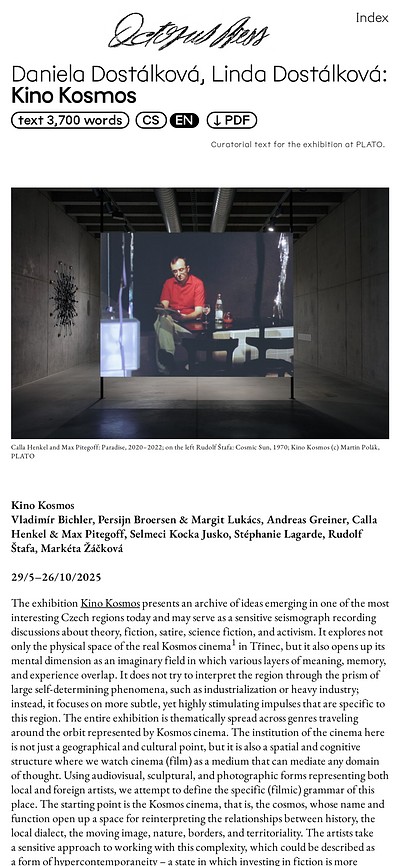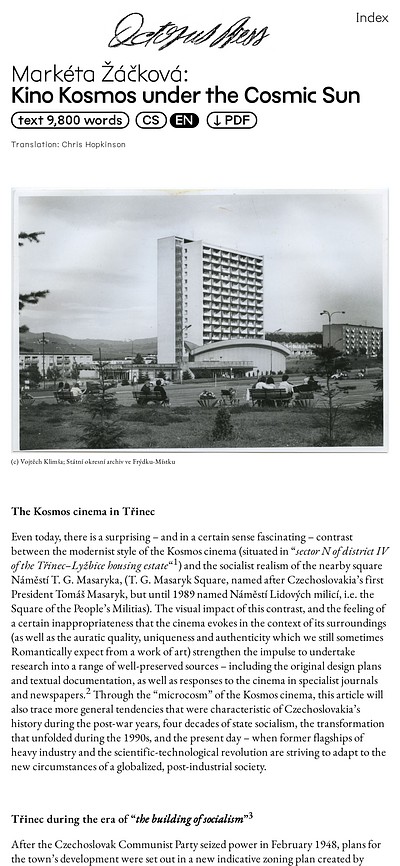Dorota Jurczak: Pyk, Sciak etc.
Curatorial text for the exhibition at PLATO.
Dorota Jurczak: Pyk, Sciak etc.
29/5–26/10/2025
In her dark, fantastical works, Polish artist Dorota Jurczak constructs a unique mythology, in which a central role is played by mysterious, fragile, and disturbing creatures, often inspired by Eastern European iconography. Her sculptures, reliefs, drawings, and prints update the legacy of historical crafts, while intertwining in a narrative about transience and corporeality. Dorota Jurczak’s work is highly stylized, reminiscent of snippets of some mystical tale that defies traditional logic. The artist draws from puppetry and its ability to bring to life characters and transform them into narrative vehicles. Like in the Czech tradition, where the puppet’s existence immerses the viewer in constant tension between animation and dead matter, the characters created by this Polish artist live in strange, dreamlike worlds bearing this paradoxical dynamic. The constant dialogue between vulnerability and a dark force gives them a disturbing but at the same time fascinating character. The artist manages to use contemporary visual codes to elegantly portray an unmistakable expressiveness, as well as a clumsiness and defiance, so that her works – in which we can recognize the influence of characters from fine literature, comics, and children’s books – take on the character of ritual, otherworldly objects radiating a sort of deeper knowledge. We are put face to face with creatures that do not impose themselves on us yet which we cannot ignore.
Stylized human and animal figures in various forms, crafted with perfect technique, call to mind mystical entities in which a domesticated form intertwines with a hint of ceremonial and archetypal meaning. Here, animal and human features are seemingly remolded, softened, or adapted to human tastes and ideas about cuteness, controllability, and kindliness, as if Dorota Jurczak has documented what was occurring in a parallel reality that she has created herself. She thus loosens up for us the rigidity of human storytelling, while creating a space for other-than-human voices-narrators to thrive.
The artist’s profound interest in material, its precise crafting, and her mindful approach to using techniques enable her to adapt new formulas, change scales, and aesthetically deceive – that is, to deliberately throw us off balance – and in the process make her works deeply immersive. Ceramics and traditional glazing techniques, bronze, drawing, painting, etching retouched with pastels – artisanal approaches drawing on the continuity of historical craft methods here are not just formal elements but an active part of narration, which emphasizes the transience and corporeality of these forms. Fragments of well-known aesthetic references defy strict categorization despite their iconic nature. We can project into them narratives on the boundary between allegory and fable, or view these anthropomorphic figures as restless creatures and actors with elusive character traits, as unstable totem poles, whose ceramic fragility and pictorial sophistication evoke restlessness and nostalgia and which may all the same carry us away to a fairy-tale world or a children’s game, or bring to life figures in a ritual act, in which motionless matter disturbingly comes to life for a moment.
A trio of human figures appear in the exhibition in the form of a relief. A trio of glazed stoneware heads – Blumka, Szumka i Kropka (Blumka, Szumka, and Kropka, 2024) – with closed eyes and mouths reminiscent of gargoyles seems as if it has just stepped out of the literary world of Witold Gombrowicz. His symbolically and physically different characters reflect the author’s fascination with absurdity, parody, and the issue of identity; the characters reflect Gombrowicz’s tendency to depict human existence as being split between the inner world and outer expectations. We find a similar ambivalence in the work of Dorota Jurczak, whose hybrid creatures (animal or surreal heads, fragmented torsos, and human legs) offer an interpretive openness that seemingly goes beyond current events, socioeconomic contexts, and the artistic discourse, but which nonetheless manage to convey with great intensity physically grounded, highly emotional experiences. Whereas in Gombrowicz’s novels this divided nature is more existential and psychological, in Dorota Jurczak’s work it takes shape through bodily metamorphosis. Such depiction supports the interpretation of artworks combining human and animal elements as a means of expressing posthumanist themes and criticism of anthropocentrism.
Besides the three heads, we also find at the exhibition a trio of pig busts: Ściak, Pyk, and Kanka (2024). These hogs seem to be carrying a story, which remains hidden from us to the extent that these fairy tale–looking sculptures can start to seem a bit scary once we observe them for a while.
When humans do enter the artist’s creative realm, they most often come in the form of legs and shoes, that is, the lower half of the figure. Such a grotesque depersonalized body remains grounded in reality, whereas the head grows overly large, transforms, and breaks free from human form. This formal division of proportions, scale, and expectations creates tension between the human body and animal identity, while at the same time rethinking humankind’s position – it suggests an effort to disrupt the hierarchy in which humans are viewed as creatures superior to others. A pair of spatial installations, shoestairs (2020) and shoewall (2020), clearly reference the environment of a shoe store. Shoeboxes create the architectural framework for exhibiting shoes exactingly modeled from glazed ceramics, which exist only as a single piece. These individual shoes, with their markedly elongated, deformed shapes, waver back and forth between elegance and grotesqueness. At the same time, they call to mind theater props – such shoes could belong to both an elegantly dressed man or a clown, and their expressive power lies in this ambivalence between the comic and the serious. The diptych ulica I i ulica II (street I and street II, 2020), which depicts the motif of footwear in motion, contrasts with these static objects. These works, made with vinyl paint and ink on wallpaper, are unusually mounted at a slant, which disrupts the expected level of reading and strengthens the impression of the scene’s fluid rhythm.
Choreography is also evoked by a series of newly created etchings with chine collé, Untitled (2025), and the drawing na spacerek (on a walk, 2025), which presents figures (their legs) walking. A mischievous scene of dogs and their walkers greeting each other once again lets us guess what they actually look like, even though it gives a sense of wholeness. A clue to the whole, that is, to the environment in which Dorota Jurczak’s figures appear, is provided by three intaglio prints in five successively painted colors: Nuna, Nusia i Blumka (Nuna, Nusia, and Blumka, 2023). These works, depicting an identical scene but in different colors, present a situation taking place in a hall or entranceway. A carefully arranged scene featuring a woman, girl, and poodle in three color variants shows how significantly the atmosphere of a single space can transform – from an ordinary scene of departure to a frosty moment of tension in which color ceases to be a mere decoration and becomes the driver of action.
The works Ulica Stalowa 7 (Stalowa Street 7), Ulica Stalowa 8 (Stalowa Street 8 ), and Ulica Stalowa 10 (Stalowa Street 10; 2024) seem to be poured from concrete. In reality, under the gray surface is bronze, and even though as a material it remains hidden to the eye, it gives the objects a kind of nobleness and is a vehicle of inner tension between the surface and core. From a distance the works look like ancient columns, architectural fragments of the past. From up close, however, the shape disintegrates into soft shelters, cushions, pebbles, and rounded walls, with which tiny pigs nearly merge – they become part of them; they lose their outlines as if they wanted to hide, dissolve, or perhaps stay unexposed.
We can only imagine what the background of these beings would look like if the artist allowed us to view it. Would we find ourselves on Orwell’s Animal Farm or would we have instead entered into the stylized, surreal space of Švankmajer’s Little Otik (Otesánek ), where logic is bent and characters change shape and meaning? Perhaps we would feel the stifling atmosphere of Kafka’s tales, in which human identity collapses under the weight of outside forces and absurdities, or perhaps we’d find ourselves in the dark fairy-tale forests of the Grimm Brothers, where the lines between human, animal, and monster are obscured. Or has the artist not set her beings in a specific environment on purpose and intentionally left them unanchored so as to underline their mysterious, ungraspable nature and make simple categorization impossible?
Many of her works seem to be “perfect objects” – not in a practical sense but in terms of sophistication and internal cohesion, which is, however, self-contradictory. It is manifest in the ability of the work to combine elements that are at first glimpse in conflict: elegance and grotesqueness, archaic forms and contemporary codes, ritual symbolism and pop-culture aesthetics. The tense yet functional relationship between seemingly incompatible elements creates an autonomous world in which inner logic makes sense thanks to this complex heterogeneity.
Dorota Jurczak manages to masterfully bypass contemporary media, techniques, and visual references, but still creates her own genre, visual mythology, and iconography, which do not come off as being historicist. Here, the past is not a closed book, but a living, porous database, open to interpretation and new discoveries. At the same time, it is intuitive, associative, fragmentary, and urgent – and through openness, emotional complexity, and visual accessibility, it allows the viewer to enter into the work from a personal perspective.
Daniela & Linda Dostálková
The artist has participated in many international shows, and her works have been exhibited at institutions such as Tate Modern in London, Kunsthall in Bergen, Van Abbemuseum in Eindhoven, the CAPC Museum of Contemporary Art in Bourdeax, and MoMA PS1 in New York. She resides in Palermo.
- Language
- Type
- Palate Cleanser2025
- cs
- en
text- 2,000 words
- Monika Pascoe Mikyšková: Memories that aren’t mine2025
- cs
- en
text- 500 words
- Kino Kosmos under the Cosmic Sun2025
- cs
- en
text- 9,800 words
- Kino Kosmos2025
- cs
- en
text- 3,700 words
- Dorota Jurczak: Pyk, Sciak etc.2025
- cs
- en
text- 1,500 words
- Sprouts2025
- cs
- en
text- 800 words
- Curatorial text for the exhibition by Petr Bosák, Robert Jansa and Adam Macháček2025
- cs
- en
text- 900 words
- Curatorial text for Martin Zetová's exhibition2025
- cs
- en
text- 1,100 words
- Cello & Piano2025
- cs
- en
audio - Primeval Forest, Garden and Wall2024
- cs
- en
- pl
text- 1,100 words
- Interview with Barbora Lungová2024
- cs
audio - Barbora Lungová and the gift of painting2024
- cs
- en
text- 1,400 words
- Julie in the Worlds of Fantasy. Marginalia.2024
- cs
- en
text- 1,600 words
- Pigeon newspaper2024text
- Workbook for children The Shell No. 32024
- cs
- en
text- 200 words
- Zvířecí kustodi – Bee2024
- cs
- en
video- 32’32”
- Animal Custodians – Rabbit2024
- cs
- en
video- 33’18”
- Animal Custodians – Owl2024
- cs
- en
video- 28’05”
- Animal Custodians – Fox2024
- cs
- en
video- 32’05”
- Animal Custodians – Deer2024
- cs
- en
video- 33’45”
- Animal Custodians – Pigeon2023
- cs
- en
video- 32’20”
- Animal Custodians – Raven2023
- cs
- en
video- 21’24”
- If you have a canary with a poor singing voice, it will never stop singing after this training video!2023
- cs
- en
video- 21’24”
- Checking the Stove2023
- cs
- en
video- 5’34”
- 0’40”
- Trust2023
- cs
- en
video- 7’03”
- Is it the flight or the fall what my friend is falling for?2023
- cs
- en
video- 12’08”
- Animal News2023
- cs
- en
text- 1,500 words
- Dan Walwin: Relief2023
- cs
- en
text- 1,000 words
- Ukrainian Culture at the Time of Russian Aggression2023
- cs
- en
text- 100 words
- Freely Accessible Books on the Topic of Ukrainian Culture at the Time of Russian Aggression2023
- cs
- en
text- 500 words
- They Thought We Were Alive and They Run Screaming2023
- cs
- en
text- 1,200 words
- On Renewed Land: Locating Ukrainian Destiny2023
- cs
- en
text- 1,900 words
- I Can Hear the Grass Grow2023
- cs
- en
text- 600 words
- Interview related to the exhibition Optimised Fables about a Good Life2022
- cs
- en
text- 900 words
- Interview related to the exhibition Optimised Fables about a Good Life2022
- cs
- en
text- 900 words
- Interview related to the exhibition Optimised Fables about a Good Life2022
- cs
- en
text- 700 words
- Interview related to the exhibition Optimised Fables about a Good Life2022
- cs
- en
text- 1,700 words
- Interview related to the exhibition Optimised Fables about a Good Life2022
- cs
- en
text- 1,000 words
- Interview related to the exhibition Optimised Fables about a Good Life2022
- cs
- en
text- 1,100 words
- Interview related to the exhibition Optimised Fables about a Good Life2022
- cs
- en
text- 900 words
- Interview related to the exhibition Optimised Fables about a Good Life2022
- cs
- en
text- 1,600 words
- Interview related to the exhibition Optimised Fables about a Good Life2022
- cs
- en
text- 900 words
- Interview related to the exhibition Optimised Fables about a Good Life2022
- cs
- en
text- 1,400 words
- The Night2022
- cs
text- 0 words
- Optimised Fables about a Good Life2022
- cs
- en
text- 800 words
- In the footsteps of the Greek underground II: Longing for deep time2022
- cs
- en
text- 7,200 words
- In the footsteps of the Greek underground I2022
- cs
- en
text- 12,800 words
- Elective Affinities: “Anarchism Without Adjectives”. On the Work of Christopher D’Arcangelo 1975–1979 with Dean Inkster and Pierre Bal-Blanc2022
- cs
- en
video- 58’01”
- Curatorial Control2022
- cs
- en
text- 2,500 words
- Ruins. Reconstruction of the past and construction of the future2022video
- 1h 14’43”
- Long Evening with Octopus Press2022
- cs
audio - Oh and Hah, Beauty, Ruin and Slack2021
- cs
- en
text- 900 words
- Our Living Ruins2021
- cs
- en
- pl
text- 3,100 words
- Troubling Time/s and Ecologies of Nothingness: Re-turning, Re-membering, and Facing the Incalculable2021
- cs
- en
text- 16,400 words
- Re/un/doing the Ruin2021
- cs
- en
text- 2,800 words
- Usableness of the list / Portfolio2021
- cs
- en
audio - Tied to Landscapes2021
- cs
- en
text- 800 words
- Tied to Landscapes2021video
- 9’49”
- A Small Encyclopedia of Improprieties2021video
- 12’18”
- Humans need not apply2021
- cs
- en
text- 900 words
- Poems2021
- cs
- en
text- 200 words
- Carbon Care2021
- cs
- en
text- 1,400 words
- Bouvard and Pécuchet. A Tragi-comic Novel of Bourgeois Life2021
- cs
- en
- fr
text- 12,300 words
- And Again G. F.2021
- cs
- en
text- 700 words
- On The Immortality of Art Institutions2021
- cs
- en
- pl
text- 1,500 words
- Expedition PLATO2021video
- 47’25”
- The Great Transformation. The Political and Economical Origins of Our Time2021
- cs
- en
text- 4,800 words
- Digestive Tract2021video
- 14’35”
- Notre Dame of Ruins2021
- cs
- en
- fr
text- 1,100 words
- Who is Afraid of Ruins?2021
- cs
- en
- pl
text- 1,300 words
- The Ruin2021
- cs
- en
- de
text- 3,000 words
- Zapomínání a infrastruktura2021video
- 13’19”
- Forgetting and infrastructure2021
- cs
- en
text- 2,000 words
- Olympia2021image
- Purification II, 20202021video
- 3’35”
- Purification I, 20202021video
- 1’49”
- Chaos: how to ruin a ‘ruin’ and love a ‘ruin-in-love’, I think2021
- cs
- en
text- 5,400 words
- (Introduction) Chaos: how to ruin a ‘ruin’ and love a ‘ruin-in-love’, I think2021video
- 13’35”




